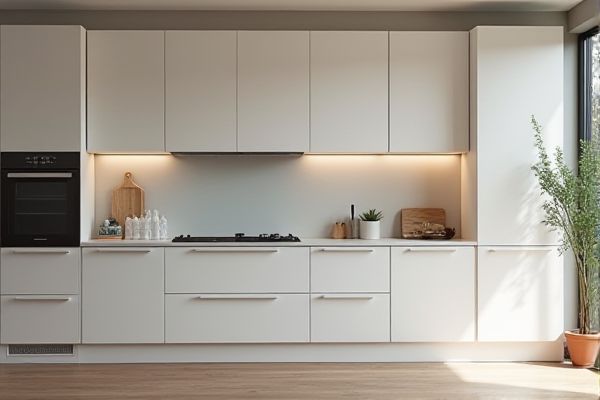
Handleless cabinets create a sleek, modern look with smooth surfaces that are easy to clean, while handled cabinets offer traditional style and practical grip options for easier opening. Discover which cabinet style suits your kitchen design and functionality preferences by reading the rest of the article.
Table of Comparison
| Feature | Handleless Cabinets | Handled Cabinets |
|---|---|---|
| Design Style | Modern, sleek, minimalistic | Traditional, classic, varied styles |
| Ease of Use | Push-to-open or recessed grip, sometimes less intuitive | Easy grip with visible handles |
| Maintenance | Easier to clean without external hardware | Requires cleaning around handles; hardware may tarnish |
| Cost | Generally higher due to mechanism and design | Varies; usually more affordable options available |
| Customization | Limited hardware options; focus on panel design | Wide range of handles, knobs, finishes |
| Installation | More complex due to special opening mechanisms | Standard installation with screws |
| Durability | Less wear from handles, but mechanism may require maintenance | Handles can loosen or break over time |
| Aesthetic Impact | Seamless, clean look enhances modern interiors | Decorative element adds character |
Introduction to Cabinet Styles
Handleless cabinets offer a sleek, modern look by eliminating visible hardware, featuring push-to-open or integrated grip mechanisms that enhance minimalist design and maximize countertop space. Handled cabinets provide traditional functionality and decorative accents with a variety of pull, knob, and bar styles, allowing for customizable aesthetics and ergonomic grip options. Choosing between handleless and handled cabinetry significantly impacts kitchen style, maintenance, and accessibility preferences.
Overview of Handleless Cabinets
Handleless cabinets feature a sleek, minimalist design that enhances modern kitchen aesthetics by eliminating visible hardware like knobs or pulls. These cabinets often utilize push-to-open mechanisms or recessed grips, offering streamlined surfaces that are easier to clean and maintain. Your kitchen will benefit from a contemporary, clutter-free look that maximizes space and provides a smooth, uninterrupted visual flow.
Overview of Handled Cabinets
Handled cabinets feature attached hardware such as knobs or pulls, providing tactile grip and easy accessibility for opening and closing. These cabinets offer a traditional or transitional aesthetic, complementing various kitchen styles with customizable finishes and materials. Ergonomically, they enhance functionality by minimizing finger strain and improving control during use, making them a popular choice in both residential and commercial settings.
Design Aesthetics: Modern vs Classic
Handleless cabinets showcase sleek, minimalist design aesthetics ideal for modern interiors, emphasizing clean lines and smooth surfaces that create a seamless look. Handled cabinets typically offer a classic appeal, with various handle styles that add character and traditional charm to kitchen or bathroom spaces. Choosing between handleless and handled cabinets significantly influences the visual style, where handleless suits contemporary settings and handled complements timeless, classic designs.
Space Efficiency and Functionality
Handleless cabinets maximize space efficiency by offering a sleek, uninterrupted surface that simplifies cleaning and reduces visual clutter in your kitchen. Handled cabinets provide tactile feedback and easier grip, enhancing functionality for individuals who prefer a more traditional approach. Your choice impacts both the ease of access and the overall aesthetic, balancing minimalist design with practical usability.
Ease of Cleaning and Maintenance
Handleless cabinets offer a sleek surface with fewer crevices, making them easier to clean and maintain by preventing dust and grime buildup. Handled cabinets require regular attention around handles and grooves, where dirt can accumulate, increasing maintenance time. Choosing handleless designs enhances your kitchen's hygiene and simplifies upkeep, saving time in daily cleaning routines.
Cost Comparison
Handleless cabinets generally cost more upfront than handled cabinets due to the sophisticated designs and hardware mechanisms required for seamless operation. Handled cabinets offer a more budget-friendly option with a variety of affordable handle styles that provide both functionality and aesthetic appeal. Your choice should consider long-term value, as handleless cabinets may reduce maintenance costs and enhance modern kitchen appeal.
Installation and Hardware Considerations
Handleless cabinets require precise door alignment and often use push-to-open mechanisms or integrated recessed grips, which demand accurate installation to ensure smooth operation without hardware protrusions. Handled cabinets involve installing knobs or pulls that must be securely fastened, with screw placement directly affecting countertop clearance and ease of use. Both types need careful attention to hardware compatibility and mounting techniques to ensure durability and functionality in kitchen design.
Suitability for Different Kitchen Layouts
Handleless cabinets offer a sleek, minimalist look ideal for modern, compact kitchens where clean lines enhance spatial perception, making them suitable for galley or small U-shaped layouts. Handled cabinets provide better grip and accessibility, benefiting larger kitchens like L-shaped or island configurations where frequent use and ease of opening are priorities. Both styles can be effectively integrated into various kitchen layouts depending on functional needs and aesthetic preferences.
Choosing the Right Cabinet for Your Space
Handleless cabinets offer a sleek, modern aesthetic and ease of cleaning, perfect for minimalist or contemporary spaces, while handled cabinets bring a classic, tactile element that enhances grip and accessibility. Your choice depends on your lifestyle needs and kitchen style: handleless suits streamlined, open layouts, whereas handles provide visual interest and practicality for traditional or busy kitchens. Consider door material and frequency of use to determine which cabinet type best complements your space's functionality and design.
 homyna.com
homyna.com